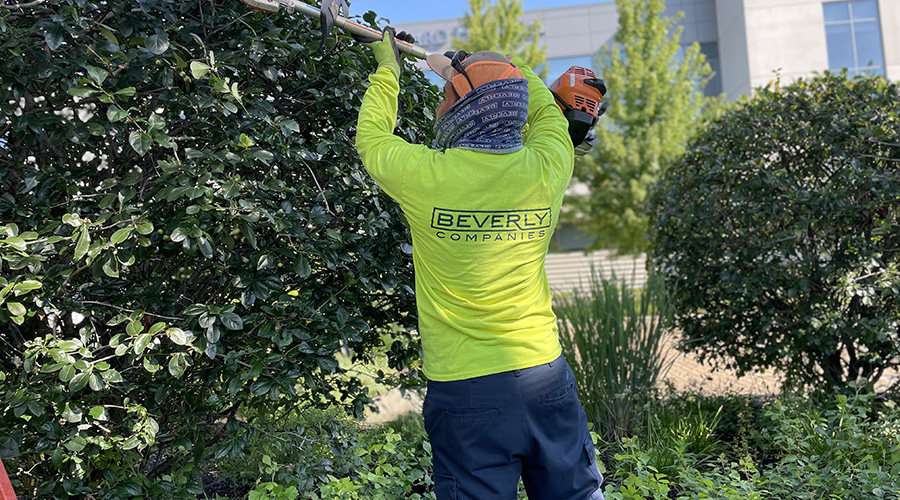Focusing on Fleets
Overseeing the workhorses of grounds care — utility vehicles, trucks and cars — requires that managers develop a comprehensive fleet-management strategy
The vehicles that grounds care departments rely on each day to move people, materials and equipment to and from work sites form the backbone of department operations. So the long-term reliability, performance of this fleet of cars, trucks and utility vehicles is essential in ensuring the department’s efficiency.
But fleet management is evolving field. A closer look at the challenges and issues related to maximizing fleet performance can help grounds care managers devise a cost-effective and flexible strategy to meet the organization’s demands.
A Matter of Money
The biggest challenge managers often face with fleet management is securing funding for replacement and proper maintenance of vehicles, says Paul Lauria, president of Mercury Associates, a fleet-management consulting firm in Gaithersburg, Md. His firm offers consulting services for public and private sector clients to evaluate and identify opportunities to improve fleet management and operating practices.
“Because the support departments and the role their vehicles play in the day-to-day operations of an organization are not well understood by financial managers, they think that cutting fleet budgets is an easy way to reduce expenses,” Lauria says. He adds that avoiding investments in the fleet infrastructure might save money immediately but usually results in higher costs later.
“Ideally, vehicles should be replaced when the annual operating costs starts to become greater than the annual capital cost,” he says. By following this type of replacement plan, managers can keep operating budgets in line and reduce the possible backlog of unmanageable fleet replacement. If departments put off vehicle replacement too long, the organization will not save money. Instead, it will be transferred from the operating budget to the capital side of the general ledger.
“To secure financing for replacement vehicles, look at all the options,” Lauria says. Cash purchases, savings plans or debts financing all have advantages and disadvantages, so managers first need to compare all of these alternatives to determine the one that is right for a particular organization.
Keeping Pace
“Keeping up with ever-changing technology and products is one of my biggest challenges,” says John Louis, fleet manager for the Peoria (Ill.) Park District. His fleet includes 25 cars, two motorcycles, 75 trucks, 44 tractors, 40 utility vehicles, 60 trailers, 75 push mowers, and 60 riding mowers. “I attend as many service and maintenance seminars as I can to stay on top of the latest technology.” Louis recommends purchasing vehicle- and equipment-specific service and parts manuals, as well as subscribing to service publications, to help stay up to date.
Managers also face a challenge in finding properly trained and experienced equipment mechanics, says Mark Teegen, fleet manager of Acres Enterprises in Wauconda, Ill. His fleet includes 166 loader tractors, 274 light- and medium-trucks, 23 cars, seven heavy trucks, 160 trailers, 79 riding mowers, 197 walk-behind mowers, and more than 1,200 miscellaneous maintenance items.
Louis handles repair issues by closely tracking equipment warranty periods. Several off-the-shelf software packages can flag repairs that might be covered under an existing warranty, which is an excellent way for managers to help departments recover some maintenance expenses. If a vehicle has problems and is under warranty, it goes back to the dealer for repairs.
“I work with several different dealers,” Louis says. “If I am not confident that the closest dealer can handle the problem, I can take it to another. Their staffs have varying expertise, too.” Maintaining strong relationships with several dealers has additional benefits.
“I have been able to borrow repair manuals and tools for my in-house staff to use,” Teegen says. “We have also had the opportunity to send our mechanics to dealer training seminars sponsored by the manufacturer.” Teegen also has had a manufacturer send out someone to train his staff.
“Even the after-market vendors have sent representatives out to provide training for our mechanics,” he says. Manufacturers generally do not offer such a service, but it is worth it to ask.
New Levels of Technology
Technological advancements related to fleet management also are occurring on shop floors and in managers’ offices. Louis says his department’s mechanics uses scanning tools and software to check the operating systems of computerized cars and trucks. Technicians have digital test meters and thermometers. Analog pressure gauges are connected to the system being checked, and they register the pressure produced by the system or component.
“Having service and parts manuals on compact discs makes research faster and the office is less cluttered,” says Louis. “The information on the discs seems to be more complete.” Managers also are tapping into technology to produce performance reports.
“Financial managers want to see the fleet management activities in hard numbers,” Lauria says. Some managers are becoming data processors, preparing and documenting detailed information on work orders, how long a project took, and how much each part costs.
Computer technology has changed the way many managers operate, and a growing number use off-the-shelf software to aid in preparing effective reports.
“I use a common spreadsheet program to help me produce monthly mechanics’ productivity reports,” Teegen says. At the end of the month, I can print out a graph that shows how much each mechanic is producing. We award a $40 tool truck gift certificate to the most improved mechanic.”
Managers also can use presentation software for training sessions, and a database can record all vehicle information.
“We can easily keep track of license plate sticker renewals, insurance reports and our clean-fuel audits,” Teegen says. “In the shops, we use an automotive program designed for individual repair shops. Our computer system is networked between our three shops, so each shop manager has access to information and history for all of our company vehicles. This program has schedules for preventive maintenance and billing built in.
“Each shop manger is responsible to make sure the routine maintenance get done and sends a bill to the department that uses the vehicle. Our fuel pumps are also computerized and print out a monthly mileage report for each vehicle. This makes it easy for the shop manager to know when each vehicle needs service.”
Some specialized management software also incorporates global positioning technology that helps managers track the usage time and location of vehicles. Other modules help managers schedule routes, coordinate repairs, monitor parts inventories, track fuel and tires, and enable detailed analysis of productivity.
Some software also will assist with scheduling and tracking grounds care functions. With the use of the Internet and e-commerce, managers can efficiently research vehicles, buy parts and dispose of used equipment. With the amount of information available on the Internet, it is easy to compare vehicle features, dealer prices, parts availability and delivery schedules. All of this information can lead to increased efficiency and cost-effective purchasing.
It is possible to buy and sell vehicles nationwide without leaving the office. The online auctions are a popular avenue for disposing of used or unneeded equipment. Take a photo of it, post it on an auction site or Internet classifieds, and sell it.
Vehicle Selection
“Our main criteria for new fleet vehicles is dependability, ease of operation, operator comfort, and availability of repair and maintenance parts,” Louis says.
For Teegen, the purchasing begins with staff input. With that information in hand, he goes to dealers and gets advice on vehicles to purchase. He also watches what the competition and other grounds crews are using.
“We always attend trade shows to see what’s new and ask our friends in the industry what is working for them,” he says.
To keep servicing manageable, Teegen recommends that managers try to stick to one manufacturer for each type of vehicle.
“Oil viscosity requirements vary from manufacturer to manufacturer, so we have to have several different weights of oil in stock; i.e. 5w30, 5w20, 10w30,” Louis says. This is just one difference between manufacturers that affects vehicle operation and service.
Outsourcing Options
Finally, organizations sometimes consider outsourcing their fleet management services as a way to combat rising costs, labor shortfalls and technological sophistication of vehicle management.
“However, with outsourcing comes a whole new set of challenges,” Lauria says. It is easy to capture the technical level of expertise with outsourcing. But managers also must consider such time-consuming tasks as bid preparation, deciding on activities to keep in-house and those that can
be contracted out, keeping contractors accountable, managing the contract, and making sure the organization gets good value from a contractor.
Often, outsourcing fleet management activities shakes up a fleet manager’s responsibilities. They now become fleet contact administrators.
Obviously, fleet management involves far more than ensuring mechanics change the oil and check the tires. Managers today must handle financial, labor, and technological challenges on their way to developing successful strategies.
A Fleet Management ‘Alternative’
Increasingly, alternative fuels enter into discussions of fleet management, most often when talk turns to utility vehicles.
The two main types of alternative fuels used today are compressed natural gas (CNG) and ethanol/gas blends (E85). Bio-diesel, electric, liquefied natural gas; propane and hydrogen are also available.
Alternative fuels, however, are not widely used at this time, and they pose several problems for fleet managers, says Paul Lauria, president of Mercury Associates, a fleet-management consulting firm in Gaithersburg, Md.
First, the purchase price of vehicles that use alternative fuels is higher than those that use diesel fuel or gasoline.
Second, the infrastructure to dispense alternative fuels is limited. Fueling stations are few and far between. The state of Virginia, for example, has only 22 CNG, 1 E85, 58 propane, 11 electric, 1 bio-diesel, two liquefied-natural-gas facilities, and none that dispense hydrogen.
Third, alternative-fuel vehicles often have low resale values because, in part because maintaining them often requires special training and certification.
“We converted several vehicles to CNG about seven years ago and found them to be unreliable, expensive to operate, limited cruising range and fuel availability,” says John Louis, fleet manager for the Peoria (Ill.) Park District. “Also, trunk space was minimal because of the fuel tanks.”
Says Mark Teegen, fleet manager of Acres Enterprises in Wauconda, Ill., “We have not used alternative fuels. I did explore the possibility of using CNG but the fuel is not in good supply and the fuel distribution center is not in a practical location.”
Public utility, as well as state and federal government fleets, are subject to special acquisition requirements under Energy Policy Act regulations. But at this time, private companies, local governments, emergency vehicles, and military and law-enforcement fleets are not mandated to use alternative fuels.
Managers interested in more information about alternative-fuel vehicles can visit www.ccities.doe.gov/vbg/consumers/maintenance.shtml, which provides information related to alternative fuels, including various types of alternative fuels, federal regulation details, tax incentives, fuel availability, and vehicle comparisons.
|
Related Topics:











